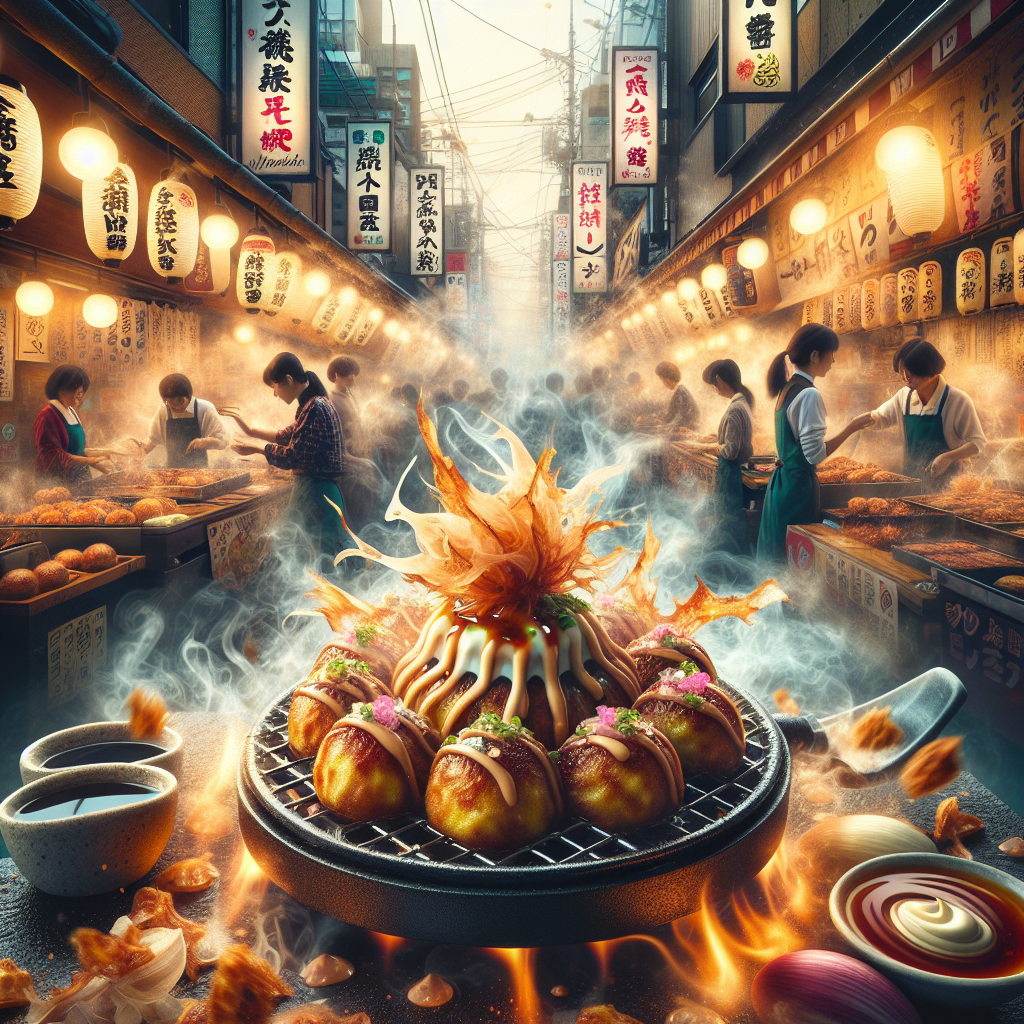Indulge your taste buds and embark on a culinary journey through the vibrant food culture of Japan’s Osaka region. Discover tantalizing flavors, intricate cooking techniques, and centuries-old traditions that have shaped this gastronomic haven. From the mouthwatering street food stalls of Osaka’s bustling markets to the elegant kaiseki dining experiences, you’ll uncover a unique blend of rustic simplicity and exquisite refinement in each dish. Get ready to savor the umami-rich flavors of Osaka’s renowned okonomiyaki, takoyaki, and sushi, as we delve into the culinary treasures of this enchanting region.

History of Osaka’s Culinary Traditions
Introduction
Osaka, located in the Kansai region of Japan, is renowned for its unique and vibrant food culture. With a rich culinary heritage that dates back centuries, the city boasts a diverse array of dishes and flavors that have become synonymous with its identity. From its early influences to the development of signature dishes, Osaka’s culinary traditions have evolved over time, blending tradition with innovation.
Early Influences
The culinary traditions of Osaka were shaped by a variety of influences. The city’s proximity to the sea made seafood an integral part of its cuisine from early on. Osaka’s position as a major trading port also exposed it to various foreign flavors and cooking techniques, influencing the development of its culinary culture.
Chinese immigrants who settled in the region brought with them their own culinary traditions, including techniques such as stir-frying and the use of soy sauce. These influences can still be seen today in Osaka’s cuisine, with dishes like “yakisoba” and “champon” showcasing the fusion of Chinese and Japanese cooking styles.
Development of Signature Dishes
Over time, Osaka developed its own unique signature dishes that have become beloved both locally and internationally. These dishes not only reflect the flavors of the region but also capture the spirit of Osaka’s vibrant food culture.
Osaka’s Unique Food Culture
Foodie Destination
Osaka has earned a well-deserved reputation as a foodie’s paradise. The city is teeming with countless restaurants, street food stalls, and izakayas, offering a wide array of culinary delights. From budget-friendly eateries to Michelin-starred restaurants, Osaka caters to all tastes and budgets, ensuring that there is always something to satisfy your palate.
Osaka’s Street Food Culture
One of the highlights of Osaka’s food culture is its bustling street food scene. Walk the streets of Osaka, and you’ll be greeted by the mouthwatering aromas of sizzling takoyaki, piping hot okonomiyaki, and freshly grilled kushikatsu. Snacking on these iconic street foods is a quintessential Osaka experience, allowing you to indulge in the city’s flavors while immersing yourself in its vibrant atmosphere.
Food Markets and Festivals
Osaka’s food markets are vibrant hubs of activity, offering a wide variety of fresh produce, seafood, and local delicacies. The most famous of these markets is Kuromon Ichiba, where you can find everything from the freshest seafood to regional specialties like takoyaki and kitsune udon.
To truly experience Osaka’s food culture, it’s also worth visiting the city during its numerous food festivals, such as the Tenjin Festival and the Osaka Naniwa Yodogawa Fireworks Festival. These events showcase the diversity of Osaka’s culinary offerings and provide an opportunity to sample a wide range of traditional dishes.

Traditional Osaka Dishes
Takoyaki
Takoyaki, a beloved Osaka specialty, consists of small balls of batter filled with diced octopus, green onions, and tempura scraps. These delightful morsels are cooked in a special takoyaki pan, creating a crispy exterior while maintaining a soft and gooey center. Takoyaki is typically topped with savory sauces, mayonnaise, and bonito flakes, resulting in a flavor explosion that is both satisfying and addictive.
Okonomiyaki
Another iconic dish from Osaka is okonomiyaki, often referred to as a savory pancake or Japanese pizza. It is made by mixing batter with shredded cabbage, meat or seafood, and a variety of other ingredients, such as green onions, tempura scraps, and even noodles. The mixture is then cooked on a hot plate, allowing the flavors to meld together. Okonomiyaki is typically topped with a tangy and savory okonomiyaki sauce, mayonnaise, and bonito flakes, creating a delicious medley of tastes and textures.
Kushikatsu
Kushikatsu is a popular Osaka street food that consists of skewered and deep-fried meat, seafood, and vegetables. The ingredients are coated in a light breading and then fried to golden perfection. These crispy bite-sized morsels are typically served with a tangy dip and are incredibly addictive.
Kitsune Udon
Kitsune udon is a simple yet satisfying dish that consists of thick udon noodles served in a fragrant dashi broth. Topped with a piece of sweet and tender deep-fried tofu, kitsune udon is a comfort food favorite in Osaka. The combination of the umami-rich broth and the subtle sweetness of the tofu creates a harmonious flavor profile that is both comforting and delicious.
Osaka-style Sushi
Osaka-style sushi, also known as “hakozushi,” is a unique variation of sushi that originated in Osaka. Unlike traditional sushi, which is typically served as individual pieces, Osaka-style sushi is made by layering vinegared rice and various toppings in a rectangular wooden mold. This creates a beautiful mosaic of flavors and textures, with each layer adding its own distinct taste. Osaka-style sushi is often enjoyed during celebrations and special occasions, making it a true delicacy in the region.
Local Ingredients and Influences
Use of Seafood
Osaka’s coastal location has had a significant impact on its culinary traditions, with seafood playing a prominent role in its cuisine. From the freshest sashimi to grilled fish, Osaka’s seafood dishes are a testament to the region’s rich maritime heritage. Local specialties like “kaisendon,” a bowl of rice topped with an assortment of fresh seafood, highlight the abundance and quality of seafood available in the area.
Importance of Dash Stock
Dash stock, or “dashi,” is a fundamental ingredient in Osaka’s cuisine. Made from kombu (dried kelp) and katsuobushi (dried and smoked bonito flakes), dashi provides a distinct umami flavor that enhances the taste of various dishes. Whether used as a base for soups, sauces, or simmered dishes, dashi is an essential component that adds depth and complexity to Osaka’s culinary creations.
Regional Produce
Osaka benefits from a diverse range of regional produce, thanks to its fertile farmland and mild climate. Local vegetables such as negi (Japanese leeks), mizuna (Japanese mustard greens), and yamaimo (Japanese mountain yam) find their way into numerous Osaka dishes, adding freshness and a touch of local flavor. Additionally, the surrounding mountains provide an abundance of wild mushrooms and bamboo shoots, which are prized ingredients in traditional Osaka cuisine.
Influence from Neighboring Regions
Osaka’s culinary traditions have also been influenced by its neighboring regions. The proximity to Kyoto, for example, has resulted in the incorporation of Kyoto’s refined and elegant cooking techniques into Osaka’s cuisine. Similarly, Wakayama Prefecture, known for its citrus fruits and high-quality soy sauce, has influenced the flavors and ingredients used in Osaka dishes. These regional influences have contributed to the unique fusion of flavors and styles that define Osaka’s culinary heritage.

Osaka’s Culinary Techniques
Steaming
Steaming is a popular cooking technique in Osaka, especially for seafood and vegetables. Steaming not only retains the natural flavors and nutrients of the ingredients but also allows for a gentle and delicate cooking process. Steamed dishes like “hamo,” a delicately flavored pike conger eel, and “yakimochi,” sticky rice cakes steamed with red bean paste, showcase the versatility and mastery of steaming techniques in Osaka’s cuisine.
Grilling
Grilling, or “yakimono,” holds a special place in Osaka’s culinary traditions. Whether it’s yakitori skewers, grilled fish, or the charred edges of okonomiyaki, grilling adds a smoky and savory flavor to many Osaka dishes. The use of charcoal grills and techniques like “hibachi,” where ingredients are cooked tableside over a small grill, adds a unique touch of theatre to the dining experience, making it a feast for both the taste buds and the senses.
Boiling
Boiling, or “nimono,” is a cooking technique widely used in Osaka to create rich and flavorful dishes. From simmered vegetables and hearty stews to broths for noodles, boiling allows for the extraction of flavors from various ingredients. Popular Osaka dishes like “nikujaga,” a simmered meat and potato dish, and “oseseri,” boiled noodles served in a savory broth, highlight the region’s mastery of the art of boiling.
Pickling
Pickling, or “tsukemono,” is an integral part of Osaka’s culinary traditions. Osaka is known for its wide variety of pickled vegetables, ranging from crunchy and tangy mizuna to subtly sweet takuan (pickled daikon radish). These pickles not only provide a refreshing contrast to the rich flavors of Osaka cuisine but also serve as a means of preserving seasonal produce. The art of pickling is deeply rooted in Osaka’s food culture, showcasing the region’s dedication to flavor preservation and culinary diversity.
Frying
Frying, or “agemono,” is a technique that plays a prominent role in Osaka’s street food culture. From the golden-brown exterior of takoyaki to the crispy perfection of kushikatsu, Osaka’s fried dishes are a testament to the city’s love of all things deep-fried. The use of high-quality oils and the precise control of cooking temperatures result in dishes that are crispy on the outside and tender on the inside, creating a delightful culinary experience.
Osaka’s Famous Food Streets
Dotonbori
Dotonbori, located in the heart of Osaka, is a must-visit destination for food lovers. Known for its vibrant neon lights and lively atmosphere, Dotonbori is home to a myriad of restaurants, street food stalls, and iconic food landmarks. From the famous Glico Man sign to traditional okonomiyaki and takoyaki joints, you can indulge in a wide array of Osaka’s culinary delights while immersing yourself in the bustling energy of this food paradise.
Kuromon Ichiba Market
Kuromon Ichiba, also known as “Osaka’s Kitchen,” is a bustling food market that offers everything from fresh seafood to traditional snacks and local delicacies. Stroll through the market and sample mouthwatering treats like grilled scallops, melt-in-your-mouth Wagyu beef, and the freshest sushi. Kuromon Ichiba is not only a feast for the senses but also a hub of culinary activity, exemplifying the diverse food culture that Osaka is known for.
Shinsekai
Shinsekai, meaning “New World,” is a vibrant neighborhood that showcases a blend of old and new Osaka. Known for its retro charm and iconic Tsutenkaku Tower, Shinsekai is also famous for its street food stalls offering Osaka specialties like kushikatsu and takoyaki. Strolling through the streets of Shinsekai, you’ll be transported back in time while savoring the flavors of Osaka’s culinary past.
Japanese Tea Culture in Osaka
Introduction to Japanese Tea
Japanese tea, or “ocha,” holds a special place in Osaka’s culinary traditions. From matcha to sencha, tea is deeply ingrained in Japanese culture and plays a significant role in various rituals and ceremonies. With its diverse flavors and health benefits, Japanese tea is not only a beverage but also an art form that reflects the values of simplicity, harmony, and tranquility.
Osaka’s Tea Houses
Osaka is home to numerous tea houses, or “chashitsu,” where visitors can experience the tranquility and beauty of the Japanese tea ceremony. These traditional tea houses offer a serene escape from the bustling city, allowing guests to immerse themselves in the world of tea and experience the mindfulness and grace that the tea ceremony embodies. Whether enjoying a cup of matcha or participating in a tea ceremony, Osaka’s tea houses provide a unique opportunity to connect with the city’s rich cultural heritage.
Tea Ceremonies in Osaka
Tea ceremonies, or “chadō” in Japanese, are an integral part of Osaka’s tea culture. These ceremonial rituals involve the preparation, serving, and savoring of tea, all done with meticulous attention to detail. Osaka is home to various tea ceremony schools and institutions that offer classes and demonstrations, allowing visitors to gain a deeper understanding of the philosophy and traditions behind the art of tea.
Osaka’s Sweet Delights
Imagawayaki
Imagawayaki, also known as “obanyaki,” is a popular sweet treat in Osaka. These small, pancake-like pastries are traditionally filled with sweet red bean paste, but variations with custard, chocolate, and even matcha fillings can also be found. The crispy exterior and soft, sweet filling make imagawayaki a delightful snack that is enjoyed by locals and visitors alike.
Taiyaki
Taiyaki, shaped like a fish, is another beloved Osaka sweet. This fish-shaped pastry is made by pouring a thick pancake batter into a mold, filling it with sweet red bean paste, and then baking until golden brown. Taiyaki is not only a delicious treat but also a visual delight that embodies Osaka’s creativity and attention to detail.
Pancake-like Treats
Osaka is known for its “kuih” or pancake-like treats, which are a staple in local street food stalls and snack shops. These fluffy, savory treats are made from a combination of flour, eggs, and various fillings such as cabbage, green onions, and seafood. Whether it’s “okonomiyaki” or “negiyaki,” Osaka’s pancake-like treats are a testament to the city’s culinary ingenuity and love of comfort food.
Glico’s Giant Sign
No visit to Osaka is complete without a stop at Glico’s giant sign. Located in the Dotonbori district, this iconic sign stands as a symbol of Osaka’s vibrant food culture. Erected in 1935, the Glico sign is an illuminated display of a running man and has become an integral part of the city’s skyline. A visit to the sign is not only a chance to capture a memorable photo but also an opportunity to immerse yourself in the energy and excitement of Osaka’s culinary heritage.
Influential Chefs of Osaka
Yoshihiro Murata
Yoshihiro Murata is one of Osaka’s most influential chefs and a proponent of traditional Japanese cuisine. As the third-generation owner of the renowned Kyoto restaurant Kikunoi, Murata is committed to preserving the culinary traditions of the region while incorporating modern techniques. His dedication to sustainable and locally sourced ingredients has earned him international recognition and made him a leading figure in the world of Japanese cuisine.
Tadamichi Ota
Tadamichi Ota, a native of Osaka, is a chef who has dedicated his career to promoting Japanese food culture. He is the proprietor of the renowned restaurant Otafuku, known for its exquisite kaiseki cuisine. Ota’s commitment to using seasonal ingredients and his meticulous attention to detail are reflected in his beautifully crafted dishes, which have garnered praise from diners around the world.
Kaoru Arai
Kaoru Arai is a young and talented chef who has gained recognition for his innovative approach to Osaka cuisine. With a focus on locally sourced ingredients and a passion for combining traditional flavors with modern techniques, Arai’s dishes showcase the evolving nature of Osaka’s culinary traditions. His commitment to culinary craftsmanship has earned him accolades both domestically and internationally, making him a rising star in Osaka’s culinary scene.
Preserving Osaka’s Culinary Heritage
Traditional Cooking Schools
Osaka is home to various traditional cooking schools that aim to preserve and promote the region’s culinary heritage. These schools offer classes and workshops where both locals and tourists can learn the techniques and traditions behind Osaka’s iconic dishes. By passing on their knowledge and skills to future generations, these cooking schools play a vital role in ensuring that Osaka’s culinary traditions are preserved and celebrated.
Osaka’s Food Museums
Osaka is also home to several food museums that provide visitors with a unique opportunity to explore the city’s culinary heritage. These museums offer exhibits on the history of Osaka’s cuisine, interactive displays, and tastings of local specialties. By showcasing the rich culinary traditions of the region, these museums contribute to the preservation and appreciation of Osaka’s food culture.
Efforts for Cultural Sustainability
Efforts are also being made to ensure the long-term sustainability of Osaka’s culinary traditions. Local initiatives, such as promoting the use of seasonal and locally sourced ingredients, supporting small-scale producers, and encouraging sustainable fishing practices, are helping to preserve the region’s culinary heritage for future generations. By prioritizing sustainability and fostering a sense of pride in Osaka’s food culture, these initiatives are ensuring that the flavors and traditions of Osaka will continue to thrive.
In conclusion, Osaka’s culinary traditions are a vibrant tapestry of flavors, techniques, and influences that have evolved over centuries. From its early influences to the development of signature dishes, Osaka’s food culture is a reflection of its history, geography, and the creativity of its people. Whether you’re exploring the bustling streets of Dotonbori, savoring the umami-rich dashi in a bowl of kitsune udon, or experiencing the tranquility of a tea ceremony, Osaka’s culinary heritage is a feast for the senses that will leave you with a deeper appreciation for the region’s rich food culture.

